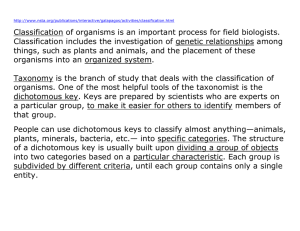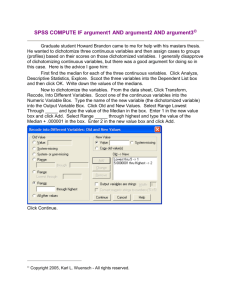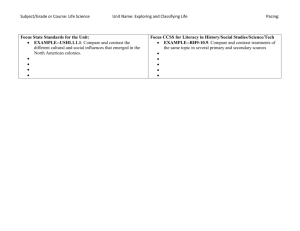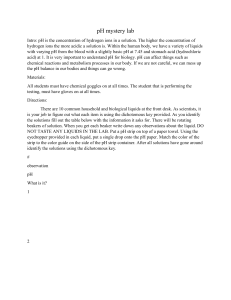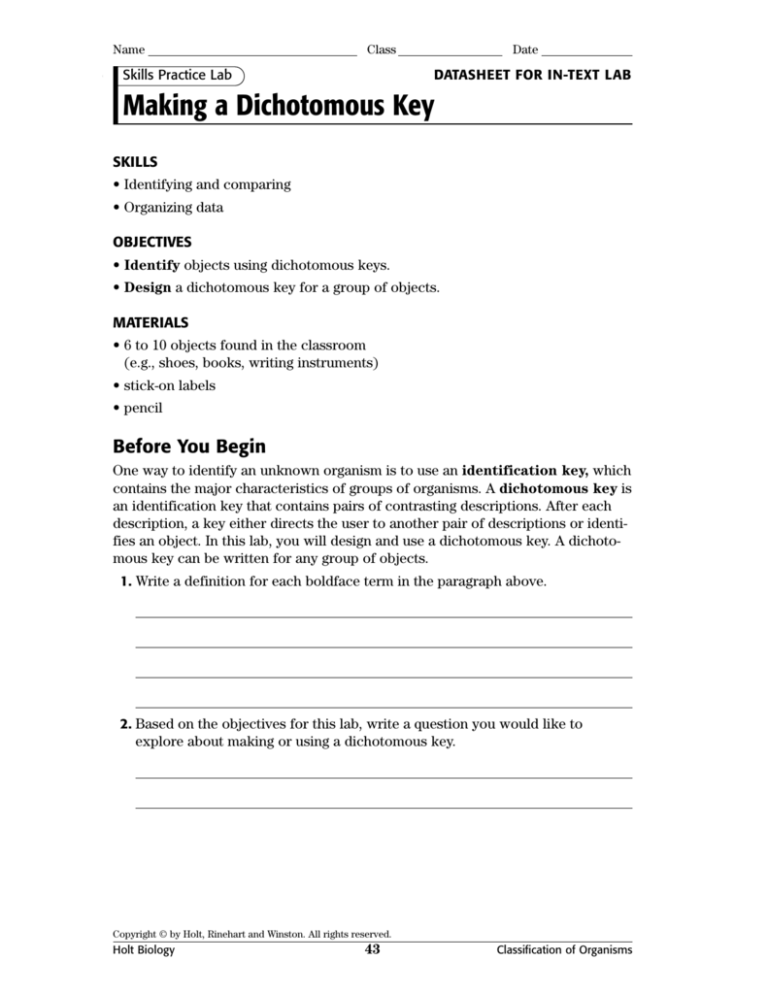
Name
Class
Skills Practice Lab
Date
DATASHEET FOR IN-TEXT LAB
Making a Dichotomous Key
SKILLS
• Identifying and comparing
• Organizing data
OBJECTIVES
• Identify objects using dichotomous keys.
• Design a dichotomous key for a group of objects.
MATERIALS
• 6 to 10 objects found in the classroom
(e.g., shoes, books, writing instruments)
• stick-on labels
• pencil
Before You Begin
One way to identify an unknown organism is to use an identification key, which
contains the major characteristics of groups of organisms. A dichotomous key is
an identification key that contains pairs of contrasting descriptions. After each
description, a key either directs the user to another pair of descriptions or identifies an object. In this lab, you will design and use a dichotomous key. A dichotomous key can be written for any group of objects.
1. Write a definition for each boldface term in the paragraph above.
2. Based on the objectives for this lab, write a question you would like to
explore about making or using a dichotomous key.
Copyright © by Holt, Rinehart and Winston. All rights reserved.
Holt Biology
43
Classification of Organisms
Name
Class
Date
Making a Dichotomous Key continued
Procedure
PART A: USING A DICHOTOMOUS KEY
1. Use the Key to Forest Trees to identify the tree that produced each of the
leaves shown. Identify one leaf at a time. Always start with the first pair of
statements (1a and 1b). Follow the direction beside the statement that
describes the leaf. Proceed through the key until you get to the name of
a tree.
A
D
B
C
E
F
Key to Forest Trees
1a Leaf edge has no teeth, waves, or lobes
go to 2
1b Leaf edge has teeth, waves, or lobes
go to 3
2a Leaf has a bristle at its tip
shingle oak
2b Leaf has no bristle at its tip
3a Leaf edge is toothed
go to 4
Lombardy poplar
3b Leaf edge has waves or lobes
go to 5
4a Leaf is heart-shaped
red bud
4b Leaf is not heart-shaped
live oak
5a Leaf edge has lobes
English oak
5b Leaf edge has waves
chestnut oak
PART B: DESIGN A DICHOTOMOUS KEY
2. Work with the members of your lab group to design a dichotomous key using
the materials listed for this lab.
Copyright © by Holt, Rinehart and Winston. All rights reserved.
Holt Biology
44
Classification of Organisms
Name
Class
Date
Making a Dichotomous Key continued
You Choose
As you design your key, decide the following:
a. what question you will explore
b. what objects your key will identify
c. how you will label personal property
d. what distinguishing characteristics the objects
have
e. which characteristics to use in your key
f. how you will organize the data you will need
for writing your key
3. Before you begin writing your key, have your teacher approve the objects
your group has decided to work with.
4. Using the Key to Forest Trees as a guide, write a key for the objects your
group selected. Remember, a dichotomous key includes pairs of contrasting
descriptions.
5. Use your key to explore one of the questions written for step 2 of
Before You Begin.
6. After each group has completed step 5, exchange keys and the objects they
identify with another group. Use the key you receive to identify the objects.
If the key does not work, return it to the group so corrections can be made.
PART C: CLEANUP
7.
Clean up your work area and all lab equipment. Return lab equipment to
its proper place. Wash your hands thoroughly before you leave the lab
and after you finish all work.
Analyze and Conclude
1. Drawing Conclusions What tree produced each of the leaves shown in
this lab?
Copyright © by Holt, Rinehart and Winston. All rights reserved.
Holt Biology
45
Classification of Organisms
Name
Class
Date
Making a Dichotomous Key continued
2. Forming Hypotheses What other characteristics might be used to identify
leaves using a dichotomous key?
3. Analyzing Methods How was the key your group designed dichotomous?
4. Evaluating Results Were you able to use another group’s key to identify
the objects for which it was written? If not, describe the problems you
encountered.
5. Analyzing Methods Does a dichotomous key begin with general descriptions
and then proceed to more specific descriptions or vice versa? Explain your
answer, giving an example from your key.
6. Further Inquiry Write a new question about making or using keys that could
be explored with another investigation.
Copyright © by Holt, Rinehart and Winston. All rights reserved.
Holt Biology
46
Classification of Organisms


